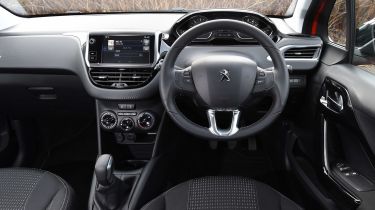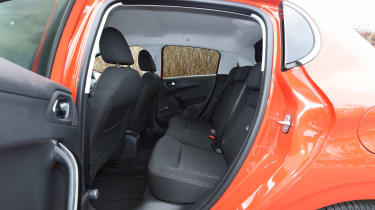Used Peugeot 208 (Mk1, 2012-2019) - How practical is it?
Despite its size, the Peugeot 208 Mk1 is pretty practical by small car standards
The Peugeot 208 Mk1 is a fairly roomy supermini: space inside for passengers is pretty good, and the boot also is handily spacious. Equipment levels across the board are good for the most part, and all cars come with a decent amount of safety features,. However, we’d advise avoiding the entry-level Access models if you’d prefer a used 208 Mk1 with a few bells and whistles.
Dimensions and cabin space
Being a supermini, the Peugeot 208 Mk1 is unsurprisingly one of the more petite cars you’ll find on the road. The car measures 3,973mm long, 1,739mm wide and 1,460mm tall, which is in the same ballpark as many contemporary rivals, such as the Ford Fiesta.
For a car of this size, passenger space is pretty decent in the Peugeot 208 Mk1. There are good amounts of room overall up front, and the headroom and legroom for rear-seat passengers isn’t too shabby, either. However, it will be a squeeze to fit three adults on the rear row.
Do also bear in mind that practicality does take a bit of a hit on three-door versions compared with the five-door models of the Peugeot 208 Mk1. Not only is getting into and out of the back a bit trickier on three-door cars, by virtue of the fact they don’t have an extra pair of doors, but they also have a bit less headroom on offer due to the more aggressively sloped roofline.
Used - available now
Interior storage is good for the most part, thanks to the 208 Mk1’s complement of cupholders, storage cubbies and decent-sized door bins. However, a good chunk of the space in the glovebox is taken up by the car’s fusebox.
Boot space
All versions of the Peugeot 208 Mk1 had the same boot capacity of 285 litres, which was on par with many of the car’s period rivals. Do bear in mind there’s a high load lip and the rear light clusters encroach into the boot opening, which can make loading and unloading heavier items a bit of a struggle. The load area can be increased to up to 1,076 litres by folding the rear seats back, and most models came as standard with a 60:40 split-folding rear seat arrangement for extra versatility, though the seat backs don’t fold down flush with the boot floor.
Equipment and technology
Equipment-wise, the Peugeot 208 Mk1 was pretty decent. Entry-level Access models weren’t crammed with kit, though they did at least come as standard with electric front windows and remote central locking, with later models adding cruise control and air conditioning to the mix. The Active trim may be better for you if you need more creature comforts than that, though: this spec includes all of the previously-mentioned equipment, along with 15-inch alloy wheels, a touchscreen display and split-folding rear seats.
The next rung up the Peugeot 208 Mk1 trim ladder is the Allure trim, which added dual-zone air-conditioning, privacy glass and automatic lights and wipers to the spec sheet. It looked a bit snazzier, too, thanks to its larger 16-inch alloy wheels and chrome exterior trim pieces.
On pre-facelift 208 Mk1s, the top spec trim levels were the Feline and XY grades. The former featured built-in navigation, a panoramic sunroof and larger-still 17-inch alloys, whereas the latter featured rear parking sensors and a subtly sporty handling setup. On post-facelift models, these trims were dropped in favour of a new GT-Line trim, which retained those features bar the standard-fit sunroof, on top of introducing sporty cosmetic features like a redesigned steering wheel and more aggressively bolstered front seats.
Being the sportiest versions of the 208 Mk1, the GTi hot hatch variants mostly brought to the table performance-enhancing parts such as stiffer suspension, more powerful brakes and a roof spoiler. There was also a more hardcore Peugeot Sport model that had a model-specific suspension setup and a Torsen differential that helps minimise wheelspin under acceleration. Curiously, the GTi models were also the only versions of the Peugeot 208 Mk1 that were fitted as standard with an alarm.
Safety
When Euro NCAP assessed the safety credentials of the Peugeot 208 Mk1 in 2012, it awarded the car the highest possible overall score of five stars. In the individual categories as part of the tests, the Peugeot performed the best in the adult occupant protection (88 per cent) and safety technology (83 per cent) categories. For child occupant protection, the Peugeot 208 Mk1 was given a still very good rating of 78 per cent, and a decent-if-not-exceptional score of 61 per cent for pedestrian protection.
As suggested by its strong safety technology score in the Euro NCAP tests, the Peugeot 208 Mk1 came as standard with a good amount of safety features. All cars came fitted with a speed limiter, a tyre pressure monitoring system, stability control, front, side and curtain airbags and ISOFIX child seat mounting points on the two outer rear seats.











